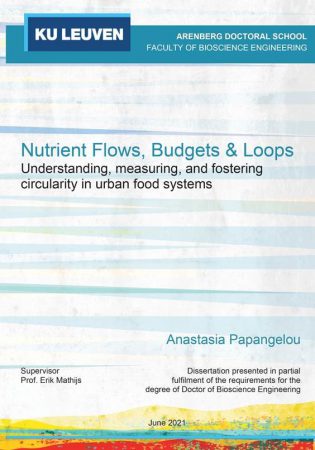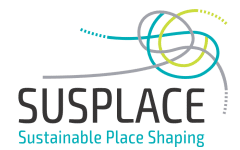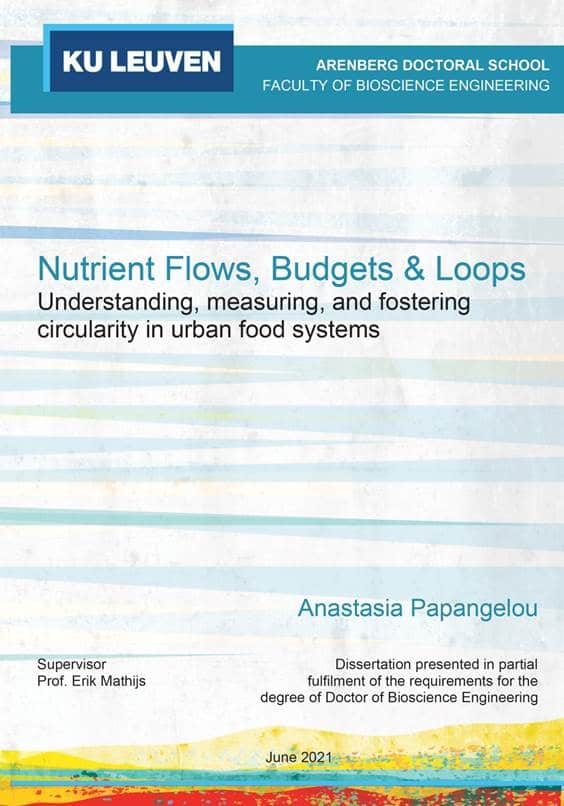
June 25 2021, Anastasia Papangelou will defend her PhD thesis ‘Nutrient flows, budgets & loops: understanding, measuring, and fostering circularity in urban food systems’. The public defense starts at 5 p.m. (CET) in the Aula of KU Leuven. The ceremony will be livestreamed.
Below a summary of the PhD-thesis. A pdf of the thesis can be downloaded here once the embargo has ended at 2021-10-01.
Since May 2021 Anastasia Papangelou is affiliated as post-doctoral researcher at the OPAALE unit of INRAE in Rennes. You can reach her at anastasia.papangelou@inrae.fr.
Summary
Cities are important nodes in a food system, even when they lack any agricultural activity. On the one hand, they concentrate consumption and drive food production; on the other, they produce big quantities of nutrient-rich effluents (organic waste, sewage sludge) that are typically wasted and not returned to the soil. Understanding and fostering the circularity of urban food systems through closing, narrowing, and slowing material and energy loops is therefore important in order to avoid this wastage of resources towards a more sustainable food system. With this goal in mind, this thesis set off to analyse the food system of Brussels with a focus on circularity, by studying nutrient flows and budgets at different spatial scales. The main objective has been to understand what urban food system circularity can be, how to measure it, and what spatial scale is most appropriate for such an analysis. To answer this questions, I analysed food and nutrient flows in the food system of Brussels Capital Region and its hinterlands, and tested different sets of circularity metrics. Starting from the city-region itself, I used a multi-layer Material Flow Analysis to analyse the phosphorus and energy flows within the administrative boundary of the city. In addition, I compared how city-scale circularity strategies simultaneously affect the amounts of phosphorus potentially available for reuse and the net amounts of energy recovered from the system. On a second step, I expanded the system boundary to include Belgium, Brussels’ domestic hinterland. Including the hinterland aimed at understanding whether the nutrients produced in Brussels are needed to cover demand in the producing agricultural lands, and how nutrient flows connecting Brussels with these lands would interact and interfere with local nutrient loops. To this end, I used an adapted GRAFS (Generalised Representation of Agri-Food Systems) approach and a spatially explicit comparison between nutrient crop needs and local nutrient supply through manure and human excreta. Finally, I adopted a footprint approach and a functional rather than geographical system boundary, in order to account for the city’s global hinterland. For this last step, I developed a resource-based phosphorus footprint that can be used to quantify direct and indirect phosphorus inputs into the food system, and to identify these parts of the hinterland that cannot be connected in a reciprocal nutrient exchange with the city. The results indicate that valorising phosphorus in urban sewage sludge and organic waste streams will not have to come at the expense of energy recovery for Brussels Capital Region. The lack of agricultural activity within the city, however, limits the usefulness of the city-level analysis and requires the inclusion of the hinterland. The agricultural lands in Flanders and Wallonia, Brussels’ domestic hinterlands, have their own abundant sources of reused nutrients to absorb. The abundance of nutrients in Flanders, mostly produced by livestock intensively reared and fed by imported crops, dominates the analysis and the circularity assessment. Wallonia, on the other hand, could potentially benefit from absorbing some of the nutrients flowing out of Brussels. Designing a more circular food system for Brussels will have to strike a balance between bringing the hinterland closer, so that the extracted nutrients can be returned to the soil, and dealing with the highly problematic nutrient flows and budgets in these near hinterlands. Ultimately, and unsurprisingly, the most effective strategies towards increased circularity are those that radically redefine the consumption and production systems, e.g. shifting away from diets rich in animal products and from intensive livestock production systems.

